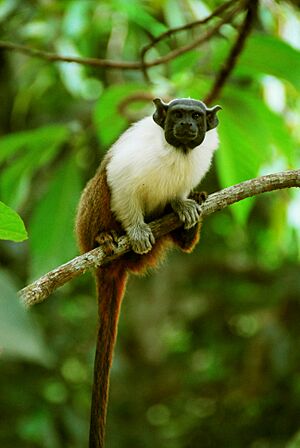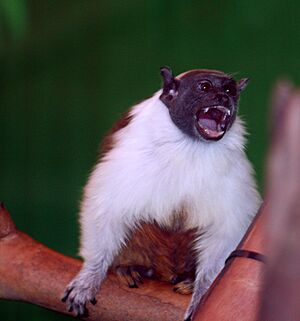Pied tamarin facts for kids
Quick facts for kids Pied tamarin |
|
|---|---|
 |
|
| Conservation status | |
| Scientific classification | |
| Genus: |
Saguinus
|
| Species: |
bicolor
|
 |
|
| The approximate range of the Pied Tamarin | |
The pied tamarin (Saguinus bicolor) is a small, unique monkey. It is also known as the Brazilian bare-faced tamarin. This animal lives in a small part of the Amazon Rainforest in Brazil.
In 2005, the pied tamarin became the official mascot of Manaus, a big city in Brazil. Sadly, this species is now very endangered. The city of Manaus is growing bigger and bigger. This growth is taking away the tamarin's natural home.
Contents
Where Do Pied Tamarins Live?
The pied tamarin is a type of New World monkey. You can find them near the city of Manaus, which is the capital of the Amazonas state in Brazil. They live up to 35 kilometers north and 100 kilometers east of the city.
Their main home is between the Cuieiras River and the Preto da Eva River. Some tamarins also live near the Preto da Eva and Urubu River, but fewer are found there.
Habitat and Competition
Pied tamarins live in different kinds of forests. They can be found in old-growth forests and sandy forests. They also live in smaller patches of secondary forest, which are forests that have grown back after being cut down. They seem to live in higher numbers in these newer forest patches.
There is a problem for pied tamarins: they face competition from red-handed tamarins. The red-handed tamarins are slowly taking over areas where pied tamarins used to live. This competition, along with their disappearing homes, makes it very hard for pied tamarins to survive.
What Do Pied Tamarins Look Like?
The pied tamarin is a small monkey. Its body is about 20.8 to 28.3 centimeters long. If you include its tail, it measures 33.5 to 42.0 centimeters.
This tamarin has a brown lower body. Its upper body is fluffy and white. Its face is black and has no hair, which is why it's sometimes called the "Brazilian bare-faced tamarin."
Special Claws
Instead of fingernails, pied tamarins have claws. These claws help them climb trees very quickly. They use their claws to find food or escape from animals that might hunt them. Their claws also let them dig into tree bark. They can then eat the sap that comes out of the tree.
Male pied tamarins weigh about 428 grams. In the wild, they usually live for about 10 years.
Pied Tamarin Behavior and Life Cycle
Living in Groups
Pied tamarins live in groups that can have 2 to 15 members. There isn't much fighting within these groups. In one forest reserve, the average group size was about 4 or 5 tamarins. In other areas around Manaus, groups averaged around 6 tamarins.
A tamarin group usually uses an area of 10 to 100 hectares as its home range.
Reproduction and Family Life
Tamarin groups are special because the females are usually in charge. In each group, only one female is chosen to have babies. This female is called the "Alpha Female." Other females in the group usually do not have babies.
A mother tamarin is pregnant for about 140 to 170 days. She usually gives birth to twins. Even though they often have twins, only one female having babies per group is a big reason why their population is shrinking.
Young tamarins are mostly cared for by their father. The mother only takes them to nurse. However, the whole group helps look after the young tamarins born to the alpha female.
What Do Pied Tamarins Eat?
Pied tamarins are omnivores. This means they eat both plants and animals. Their diet includes fruits, flowers, and nectar. They also eat insects, spiders, small animals, and bird eggs.
In the wild, their natural enemies are small cats, birds that hunt, and snakes. In cities like Manaus, pet cats and dogs can also be a danger to them. Because their natural home is being destroyed, the pied tamarin is on the IUCN Red List of endangered species. It is also on the list of the top 25 most endangered primates in Brazil.
Protecting Pied Tamarins
Why Are They Endangered?
As of 2015, the IUCN Red List says the pied tamarin is critically endangered. Experts believe their population could drop by 80% by the year 2033. This is due to human activities, competition with the golden-handed tamarin, and diseases.
Near Manaus, pied tamarins face dangers from pet cats and dogs. They can also get hurt by power lines. The illegal pet trade also harms them. Also, more farms and homes are being built, which takes away their forest home.
Conservation Efforts
The pied tamarin has some protected areas where it lives. These include Sumaúma State Park and the Adolfo Ducke Forest Reserve. Less than half of the Puranga Conquista Sustainable Development Reserve also protects them. The Centro de Instrução de Guerra na Selva (CIGS) is a large military training area that also helps protect them.
Zoos and conservation groups in Europe and America have given money to help save the pied tamarin. Even though only a few small areas are fully protected for these tamarins, efforts are being made to replant trees. This helps their natural home slowly come back.
There is also a special program to breed pied tamarins in captivity. This means they are raised in zoos or special centers. As of 2009, there were 172 pied tamarins in captivity. All of them are owned by the Brazilian government. However, it is hard to get them to have many babies in captivity. This makes it difficult to increase their numbers this way.
Why Are Pied Tamarins Disappearing?
Main Causes
Pied tamarins live very close to the fast-growing city of Manaus. As the city gets bigger, the tamarin's forest home disappears. If they can avoid busy roads and power lines, pied tamarins try to live in the small forest patches left in Manaus.
Impact on the Environment
Since pied tamarins eat plants, they help spread plant seeds. When they eat fruit, they carry the seeds to new places. This helps the forest grow and stay healthy. They also eat small animals like insects and amphibians. This helps keep the numbers of these animals in balance.
If the pied tamarin population keeps shrinking, it's not just a problem for the monkeys. It becomes a problem for the entire Amazon Rainforest ecosystem. We don't know exactly how losing the pied tamarin will affect the Amazon, but there will almost certainly be big changes.
Images for kids




